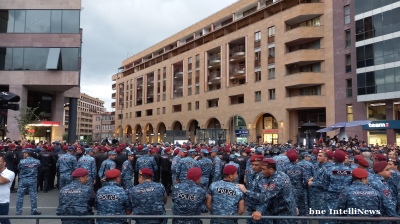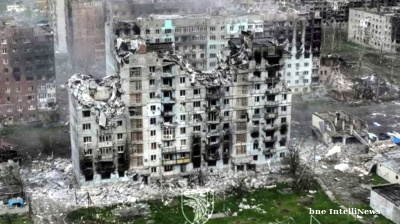Russia is set to embark on a long-term military reconstitution programme aimed at restoring the losses incurred during its full-scale invasion of Ukraine. Russian President Vladimir Putin has already increased the upper limit of men under arms to 1.5mn on September 16, but the biggest challenge will be to equip them and replace the materiel already used over the last two years of war – and pay for it.
Europe is facing the same dilemma, but, as bne IntelliNews reported, has a much more serious shortfall and a lot less money to spend on rearming. Germany, in particular, will not be able to return to pre-war levels of armament for decades.
While the Kremlin has yet to finalise the future design of its armed forces, the broad outline of its strategy is beginning to take shape, according to analyst Dara Massicot in a recent in-depth report for the Carnegie Endowment for International Peace.
Massicot warns that reconstituting Russia’s military should not be viewed as a simple restoration of pre-war personnel and equipment numbers. “Reconstitution is a process of regaining combat functions, proficiency and capabilities that will allow a force to execute various types of combat missions,” she explains. How the army will be rebuilt will depend on what Russian President Vladimir Putin wants to do: conquer the Baltic States, or defeat Nato in a world war.
Since its invasion of Ukraine, Russia has focused on reconstituting its forces without placing its economy on a full wartime footing. This has involved partial mobilisation in 2022, repairing existing equipment, purchasing weapons and ammunition from abroad to supply ongoing operations and offering substantial financial incentives to attract volunteer soldiers in lieu of a general call-up. However, Russia’s military production capacity, apart from the notable exception of drones, has plateaued as of early 2024. “Russia could generate more efficiency by reducing corruption on the margins and emphasising innovation, but this would not result in a dramatic increase in available resources,” Massicot notes. To make a serious attempt to bring stockpiles back to pre-war levels will require a complete retooling of the entire Russian economy.

Visually Confirmed Russian Equipment Losses, February 2022-April 2024
Economic strain and mobilisation
To significantly increase weapons production or manpower, Russia would need to activate further mobilisation powers, which would have profound effects on the economy, labour market, and public engagement with the war. “The Kremlin’s calculus and political will have so far constrained Russia from taking such a step,” says Massicot.
And all the new equipment needs to be paid for. Currently, direct Russia spending on the military is about 8% of GDP on defence or around $100bn a year. Military spending at the current level is likely to be sustainable to 2026.
The Federal Budget Law for 2024-2026 passed last year envisages another year of fiscal expansion in 2024, rising from total expenditure of RUB30.5 trillion ($330bn) in 2023 to RUB36.7 trillion in 2024. This increase in spending is driven by a planned hike in the “national defence” portion of the budget, which is scheduled to rise from RUB6.4 trillion ($70bn) to RUB10.8 trillion.
Other areas of the budget, such as the “domestic security and law and order” portion, are also used to finance military expenditure. Total defence spending is likely to exceed RUB13 trillion ($155bn). Social spending will rise by close to 20% in nominal terms from RUB6.5bn this year to RUB7.7bn; however, it will remain far below military expenditure. Other categories of spending are only expected to increase slightly, with most expected to rise in line with inflation.
Russian leaders continue to justify their reconstitution efforts by framing the need to replenish forces as a response to Nato expansion rather than admitting the high costs of the war in Ukraine. For now, the country is relying on refurbishing older equipment and recruiting personnel, but many of the weapons deployed are qualitatively inferior to newer models, and stockpiles of Soviet-era equipment could be depleted by 2026 if loss rates continue at current levels.
The medium-term challenge for Russia, according to Massicot, is whether it chooses to expand its forces rapidly or manage a more gradual build-up, balancing military needs with domestic stability.
“If expanding the force is of paramount importance, the current reconstitution efforts will be insufficient. Leaders will likely be forced to take steps they have so far resisted, such as activating more mobilisation powers and expanding domestic production capacity,” she writes.
“If, however, Russia prioritises economic stability, it could accept the risk of relying on existing production levels and older Soviet equipment. This strategy would be feasible only if the conflict in Ukraine freezes or ends, allowing time for a gradual build-up of new equipment through the 2030s,” Massicot adds.
Capacity limitations
Russia’s ability to increase new military equipment production is currently hampered by several structural factors.
“Space at Russian defence factories is in high demand for multiple purposes – new builds, repairs and exports – and cannot be easily converted to increase domestic production without trade-offs,” explains Massicot. Expanding production would require new factories or halting exports, both unlikely moves in the short term.
Additional options include converting civilian factories into wartime production facilities or importing military equipment, though such measures would signal a significant departure from historical norms.
"Russia could opt to import armoured equipment from other countries, but this would suggest an unwillingness to accept short-term risks and an intention to continue offensive actions against Ukraine,” she adds.
Challenges in personnel reconstitution
Rebuilding Russia’s military personnel base will also prove difficult. Wartime retention policies have prevented servicemen from resigning, masking the broader impact of the war on recruitment. While the government is offering higher wages and social benefits to attract recruits, maintaining these levels of expenditure in the post-war years would strain an already bloated defence budget.

Estimated Russian Casualties February 2022-April 2024
Vladimir Putin has increased the authorised strength of the Armed Forces for the third time since the start of the war – to 2.389mn people, of which 1.5mn are military personnel – by decree on September 16. In just two years, the Russian army has already grown by one and a half times. This increase will cost the budget, the drafting of which is in full swing, very dearly.
Increases in expenditure are difficult to support without a corresponding rise in revenues. However, Moscow has performed exceptionally well in this respect. Federal budget revenues are projected to rise from RUB28.7tn last year to RUB35.1 trillion in 2024, bringing down the budget deficit to 0.9% of GDP.
However, the Russian economy is already cooling and expected to slow sharply in 2025. That means a shift toward a full mobilisation scenario would place the budget under much greater strain. The Kremlin would be forced to increase taxation to finance the significant expansion of military spending entailed under this scenario, pushing total federal revenues to closer to 25% of GDP. Raising these taxes would draw financial resources away from households and enterprises, suppressing the potential for growth in consumption and investment, which in turn would probably slow the rate of growth. Spending on other areas of the federal budget would also be squeezed.
“At the current level of spending, and with the existing productive capacity of the defence-industrial base, reaching the targets assumed in the partial mobilisation scenario would prove difficult, especially in those areas where Russia’s wartime losses are highest. Russia’s military would be large, but the standard of equipment would vary dramatically across units,” says Massicot.
Expanding the force will require significant investment in new equipment and infrastructure, as well as recruiting professional soldiers in a society where high wages and social entitlements are expected. “These expenses would coincide with procurement pressures on an already strained budget and male labour force,” Massicot notes.
Despite large untapped human resources, such as reserve officers and women in the military, Russia has so far chosen stopgap measures like shortening military training and recruiting from prisons or abroad. Expanding the roles of women or drawing deeper into reserve forces could indicate plans for a larger military force in the future.

Officers killed in action by rank February 2022-April 2024
A return to a mixed readiness system?
Massicot suggests that Russia may ultimately return to a “mixed readiness” system, combining a smaller active-duty force of around 1mn with a large combat-experienced reserve. This system, reminiscent of the late-Soviet era, would allow Russia to maintain military potential without the costs associated with a larger standing army. “Such a force would resemble the return of the mixed readiness system of the late-Soviet and immediate post-Soviet era, a significant departure from the last twenty years of force posture,” she writes.
Russia’s ability to capture and implement lessons from its military experience in Ukraine will be crucial to shaping its future force structure. “Formal learning organisations will likely be set up in the post-war years to analyse and disseminate findings, influencing operational concepts and force design,” Massicot concludes, though political sensitivities and censorship could impede this process.
As Russia navigates the balance between rebuilding its military and managing economic constraints, the outcome of its reconstitution efforts will shape the country's defence posture for years to come.

Military equipment storage bases map

German, British and Polish arms stocks 1992-2021
Dara Massicot is a senior fellow in the Russia and Eurasia Programme at the Carnegie Endowment for International Peace. Her work focuses on defence and security issues in Russia and Eurasia. Prior to joining Carnegie, Massicot was a senior policy researcher at the RAND Corporation and senior analyst for Russian military capabilities at the Department of Defence. She has published extensively on Russian military capabilities, modernisation efforts and strategy, and is a pre-eminent expert on the Russo-Ukrainian War.
Opinion

COMMENT: Czechia economy powering ahead, Hungary’s economy stalls
Early third-quarter GDP figures from Central Europe point to a growing divergence between the region’s two largest economies outside Poland, with Czechia accelerating its recovery while Hungary continues to struggle.

COMMENT: EU's LNG import ban won’t break Russia, but it will render the sector’s further growth fiendishly hard
The European Union’s nineteenth sanctions package against Russia marks a pivotal escalation in the bloc’s energy strategy, which will impose a comprehensive ban on Russian LNG imports beginning January 1, 2027.

Western Balkan countries become emerging players in Europe’s defence efforts
The Western Balkans could play an increasingly important role in strengthening Europe’s security architecture, says a new report from the Carnegie Europe think-tank.

COMMENT: Sanctions on Rosneft and Lukoil are symbolic and won’t stop its oil exports
The Trump administration’s sanctions on Russian oil giants Rosneft and Lukoil, announced on October 22, may appear decisive at first glance, but they are not going to make a material difference to Russia’s export of oil, says Sergey Vakulenko.




